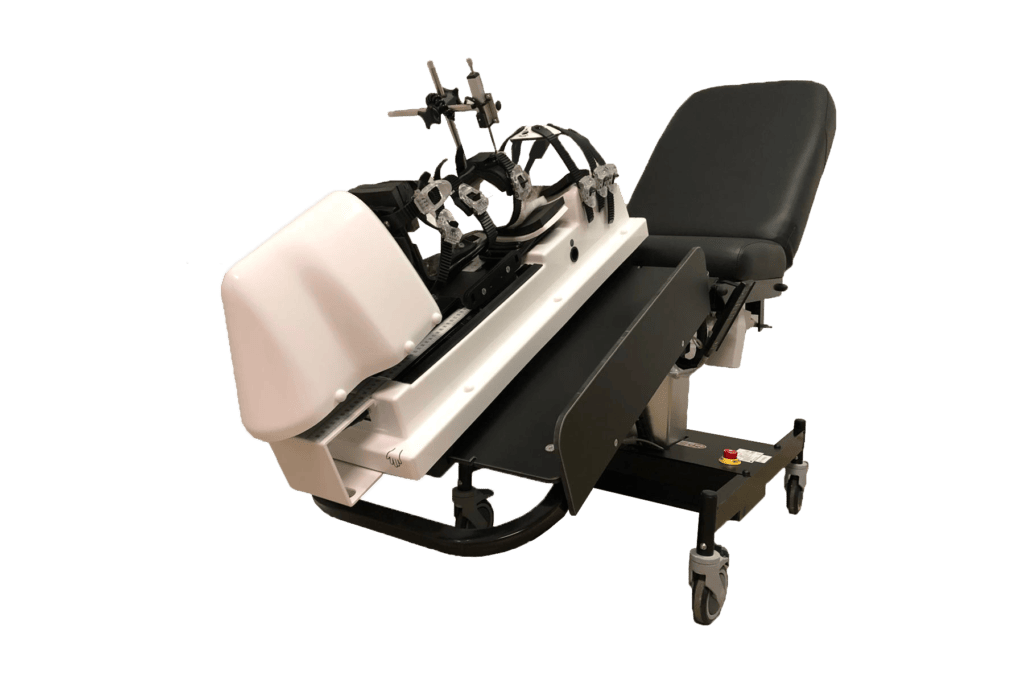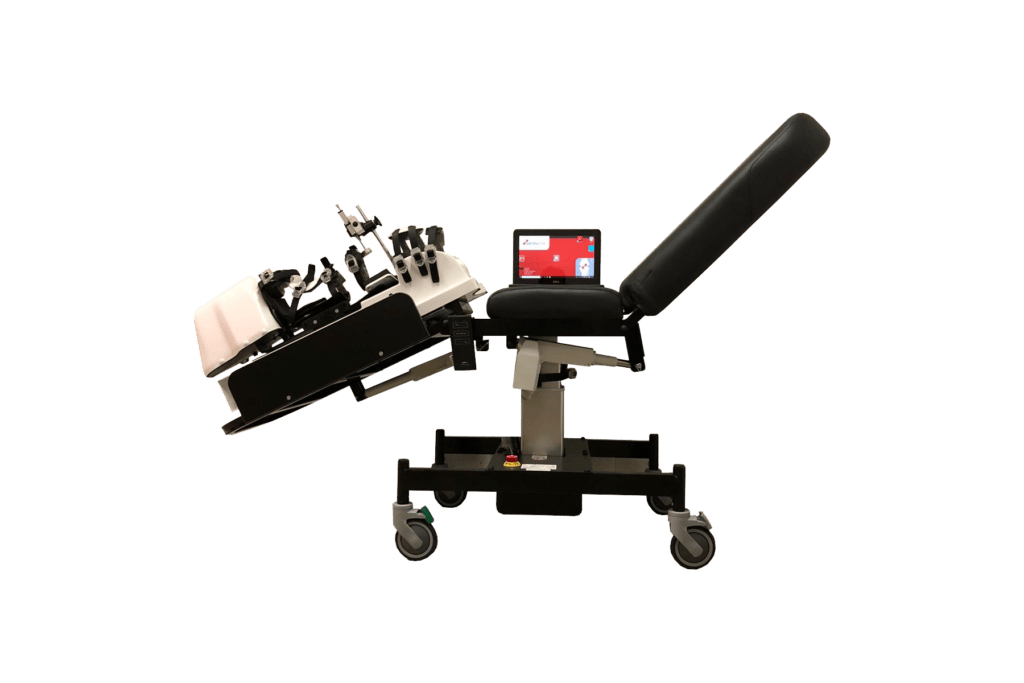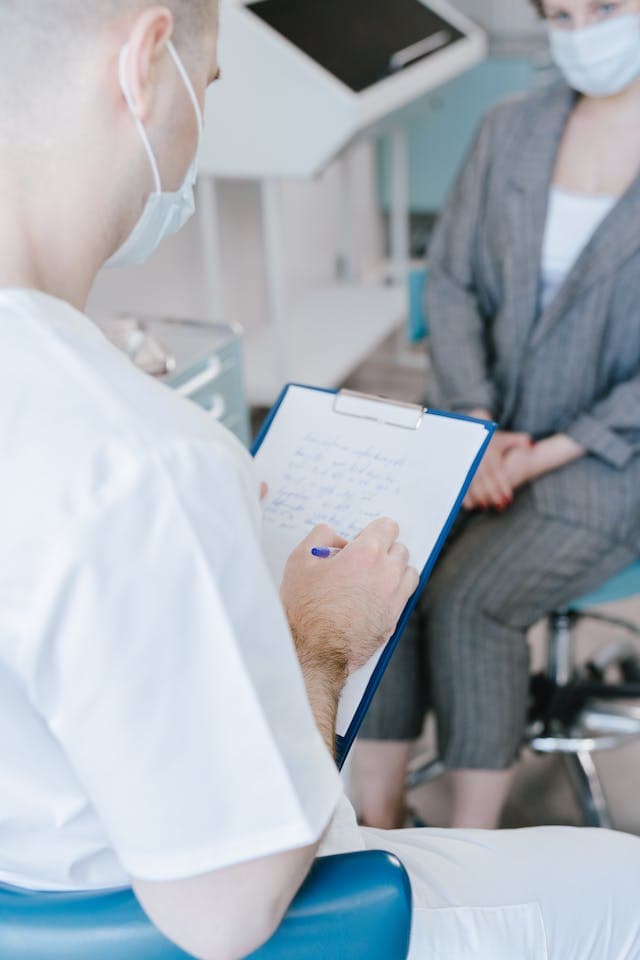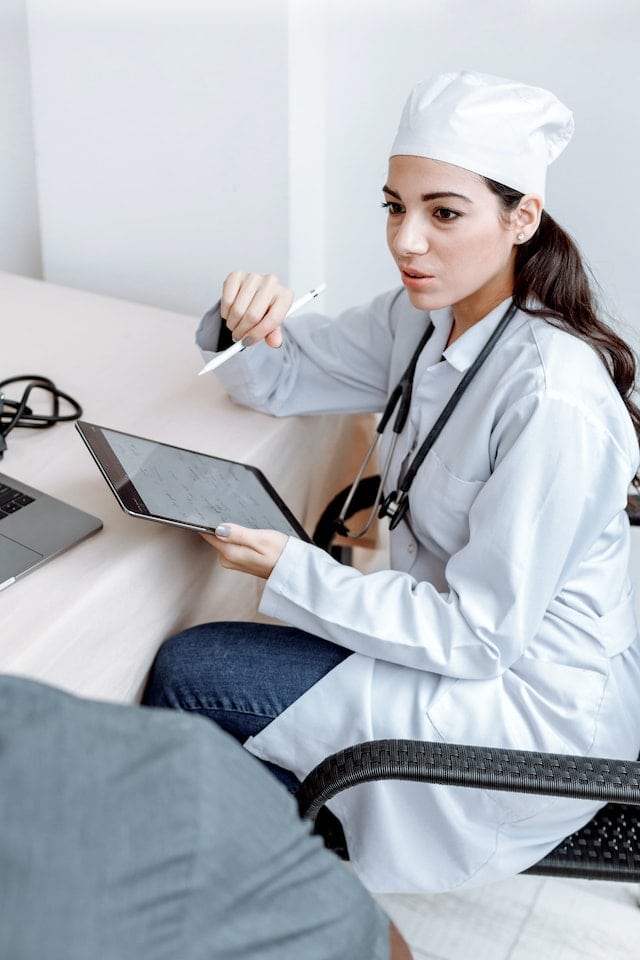Dyneelax With PCL Option - Knee Arthrometer
Knee Ligament Structures Analysed: ACL, PCL, AM-PL & AL-PM Corners
Tibials Movements: Anterior / Posterior Translation & Medial / Lateral Rotation
Designed for precision, the Dyneelax arthrometer is a pivotal medical tool for evaluating knee stability and ligament condition, perfect for health professionals. Its ergonomic design and advanced measuring capabilities ensure reliable outcomes, with a user-friendly interface that simplifies the assessment process, marking a new era in accurate knee examination & rehabilitation.
Table of Contents


Dyneelax With PCL Option Arthrometer Features
- Medical Device: High-Tech Robotic Knee Laxity Arthrometer
- Knee Dynamic Assessments Performed:
- Application of Anterior Tibial Translations to measure the state of resistance of the ACL.
- Application of Posterior Tibial Translations to measure the state of resistance of the PCL
- Inducement of Lateral Tibial Rotations to measure the state of resistance of knee ligamentous structures.
- Inducement of Medial Tibial Rotations to measure the state of resistance of knee ligamentous structures.
- Software: LDA Software – A user-friendly software developed by Genourob for optimal objective testing of the knee ligaments with an easy to access exportable database.
- Examination Couch: LDA Couch – An examination couch designed to mount the Dyneelax for optimal testing of the knee ligaments. Different knee flexions can be selected for different tests.
- Population: Wide range of normative data, from pediatric through adults, ages 8 – 100.
- After Sale: Excellent after-sale support, installation and continuing education programs.
- Warranty: 2 year-warranty.
- Shipment: Worldwide.
Dyneelax Arthrometer
1) ACL Diagnosis
2) ACL Prevention
3) ACL Rehabilitation
4) ACL Follow-up
The Dyneelax Knee Laxity Arthrometer is a medical device used for diagnosing, preventing, rehabilitating, and monitoring patients with knee ligament injuries. It offers precise assessments of knee laxity by performing automated knee translation & rotation tests, primarily focusing on the anterior cruciate ligament (ACL).
Unlike traditional arthrometers, Dyneelax applies both anterior/posterior tibial translation and medial/lateral rotation, providing dynamic and objective knee stability assessments.
Furthermore, when it comes to detecting partial ACL ruptures, Dyneelax has proven to be superior to MRI methods, ensuring a more accurate diagnosis and effective treatment plan for patients (DOI: 10.1016/j.knee.2023.03.017).
What is Dyneelax?
Unlock unparalleled clarity in knee ligament assessment with Dyneelax: where precision meets simplicity, redefining the gold standard in ligament diagnostics & Treatment.
Sensitivity: A Recent study (DOI: 10.1016/j.knee.2023.03.017) has shown GNRB & Dyneelax arthrometers exhibit superior sensitivity in diagnosing partial ACL ruptures. Where MRIs might miss or misinterpret the minutiae of a partial rupture, these arthrometers catch them.
Why Arthrometers Over MRI?
Cost-Efficient Diagnosis (90% Cost Reduction)
Economic benefits with reduced costs for both practitioners and patients.
Instantaneous & More Accurate Diagnostics
Immediate & accurate results about the state of resistance of the ACL without waiting for imaging processing.
Non-Invasive Evaluation
Reduces the need for invasive diagnostic procedures.
Free Space in MRI Rooms
Creates room for individuals battling more severe pathologies, like certain forms of Cancers.
More than 17 years have passed since Genourob unveiled the world’s first pioneering computerized knee laxity arthrometer, the GNRB. That milestone and the ensuing innovations, like Dyneelax, have established our knee laxity arthrometer as the preferred choice in elite clinics and top-tier research institutions globally.
From sports medicine and orthopedics to pediatric care and beyond, experts recognize the value of our knee laxity arthrometers. These stand as a beacon of precision and reliability in the field thanks to the data provided. This is more than mere data—it’s the pathway to superior patient outcomes, the foundation of impactful research, and the defining quality that elevates an institution above the rest.
How is Dyneelax used by Medical Practitioners?
Dyneelax: A 4 in 1 high-tech Medical Device
Diagnosis Of ACL, PCL, AL-PM & AM-PL Corner Injuries
Harnessing Dyneelax, we redefine knee ligament injury diagnosis. Especially with partial ACL ruptures, surpassing MRI's capabilities. Enter a new era of confident, precise assessments. Your knee's health, unmistakably reaffirmed.
Rehabilitation Of ACL, PCL,AL-PM & AM-PL Corner Injuries
Embrace Dyneelax's revolutionary technology as we guide you through the journey of ACL injury rehabilitation. Witness a transformation in recovery, where hope meets innovation. Rebuild with confidence and conviction.

Prevention of ACL, PCL, AL-PM & AM-PL Corners Injuries
Utilizing the cutting-edge capabilities of Dyneelax, we unveil proactive strategies to prevent ACL injuries. Venture into a future where knee safety is prioritized. Protect and prevent, with assurance.
Follow-Up Of ACL, PCL, AL-PM & AM-PL Corners
With Dyneelax as our compass, embark on a path of vigilant follow-up care for ACL injuries. Enter a realm where progress is measured, and healing is tracked with precision. Your journey, our commitment.

DOI: 10.1016/j.knee.2023.03.017

DOI: 10.1016/j.medntd.2023.100254
In which Healthcare Departments is Dyneelax utilized?
What defines Dyneelax as a crucial asset in top-tier facilities and what features does it offer?
Enhanced Objective Knee Ligament Evaluation through Dynamic Assessments
The Dyneelax knee laxity arthrometer offers objective evaluations of several knee ligament structures, including the ACL, PCL, the AM-PL & AL-PM Corners .
This device revolutionizes knee assessments by reducing subjectivity and providing clear graphical representations of ligament resistance. A notable feature of the Dyneelax arthrometer is its proficiency in diagnosing partial ACL (anterior cruciate ligament) ruptures. Impressively, its sensitivity often surpasses that of MRIs for detecting partial ACL tears.
As a result, Dyneelax stands as a cost-effective, user-friendly alternative to MRI for this diagnosis. This device is not only precise but also easy to use, making it an ideal tool for managing knee ligament health. It excels in diagnosing partial ACL ruptures, presenting a superior, affordable, and simpler MRI alternative.
In 2023, a study by Theo Cojean highlighted Dyneelax's sensitivity, repeatability, and reproducibility. Furthermore, studies from 2012 Collette et al., 2017 Jenny et al., 2022 Kayla Smith, and 2023 Magdic have validated the efficiency of GNRB in diagnosing ACL ruptures, reinforcing their clinical significance. It should be noted that GNRB technology is incorporated in the Dyneelax.





Moreover, a significant advantage of the Dyneelax arthrometer lies in its diagnostic prowess, particularly concerning partial ACL (anterior cruciate ligament) ruptures. It has demonstrated a heightened ability to detect partial ACL ruptures, often surpassing the sensitivity of MRI in this regard: 2023 – Theo Cojean – A prospective diagnostic study juxtaposing GNRB laximeter and MRI in clinical scenarios for detecting complete and partial ACL tears, validated via arthroscopy on 214 patients.
This superior sensitivity to partial ACL ruptures not only positions Dyneelax as a highly effective diagnostic tool but also presents it as a cost-effective and user-friendly alternative to MRI, addressing some of the challenges associated with MRI diagnosis of partial ACL ruptures.
The Dyneelax arthrometer is not only more precise and cost-effective but is also easier to use, with results that can easily be read without requiring extensive training. This 4-in-1 device facilitates diagnosis, prevention, rehabilitation, and follow-up of patients with knee ligament injuries, making it a comprehensive tool for managing knee ligament health. Through its objective, precise, and easily interpretable results, the Dyneelax arthrometer is poised as a superior choice for diagnosing partial ACL ruptures, thus offering a viable, cost-effective, and user-friendly alternative to MRI
Precision & Reproducibility: The Dyneelax Arthrometer's Credibility in Consistent Knee Laxity Assessments
The reproducibility of the Dyneelax knee laxity arthrometer underscores its reliability in delivering consistent results over multiple assessments (Théo Cojean Study 2023). This high degree of reproducibility is engineered through the integration of precise sensors and well-defined parameters, ensuring user-friendliness while significantly enhancing the accuracy of the tests conducted. A paramount feature of the Dyneelax is its ability to maintain identical initial conditions for each test by accurately positioning patients in the exact same manner every time a test is performed. This meticulous control over test conditions enables a precise comparison of results over time, which is instrumental especially in longitudinal studies and follow-up assessments post Anterior Cruciate Ligament (ACL) reconstruction surgery.
The aforementioned consistency in test conditions and resultant data reproducibility not only affirm the credibility of Dyneelax but also contribute to its recognition in the clinical community. This is evident from studies such as the one by Klasan which compared the Dyneelax to the KT1000 arthrometer, noting a level of precision akin to that of a navigation system. Moreover, a 2023 study by Renata Vauhnik in Slovenia reinforced the high reproducibility of the Dyneelax arthrometer, further substantiating its value in providing reliable, repeatable, and objective assessments of knee laxity. Through such continuous validation from the clinical and academic communities, the Dyneelax arthrometer emerges as an invaluable tool for healthcare professionals aiming for precise and reproducible knee laxity evaluations.” Furthermore, “Furthermore, a 2023 research initiative by Renata Vauhnik highlighted the GNRB arthrometer’s elite reproducibility, amplifying its role in delivering reliable, consistent, and impartial knee laxity measurements.

Safe ACL Assessments with Dyneelax
The safety of utilizing the Dyneelax knee laxity arthrometer, especially post Anterior Cruciate Ligament (ACL) reconstruction surgery, is of paramount importance to ensure the well-being and progressive recovery of patients. One common concern among medical practitioners is the potential risk of damaging the ACL graft during the evaluation. However, it’s crucial to note that the forces applied by Dyneelax are well within the safe and tolerable limits. For instance, studies have illustrated that the ACL experiences loads of around 350N during routine activities like walking (Download Nagura Study – 2006 or DOI: 10.1123/jab.22.4.305). In contrast, Dyneelax meticulously applies only 100N of force on the tibia when assessing the ACL graft post-surgery, which significantly minimizes any risk to the graft.
Before surgery, the force exerted can go up to a maximum of 200N to analyze knee instabilities, still maintaining a wide margin of safety. The forces administered by the Dyneelax arthrometer are precisely controlled via a computer, ensuring a highly regulated and safe testing environment. This level of control not only guarantees safety but also allows for meaningful assessments soon after surgery to evaluate the grafts and monitor the healing process meticulously. Bertrand Semay’s 2016 study (DOI: 10.1016/j.rehab.2016.07.045) focuses on the evolution of anteroposterior laxity in ACL reconstruction patients, measured by the GnRB device at 6, 9, and 12 months post-surgery (. It underscores the importance of monitoring ligament laxity for effective rehabilitation.
Furthermore, Nouveau’s 2017 research (DOI: 10.24966/ORP-2052/100035) investigates the impact of early rehabilitation activities on the stiffness of ACL grafts, emphasizing the significance of balancing early mobilization with graft healing. Another interesting study is from Forelli in 2023 (DOI: 10.26603/001c.73031). It introduces a comprehensive rehabilitation approach, particularly for soccer players, stressing the need for a blend of clinical and sport-specific assessments to ensure a successful and safe return to play. These studies collectively advance the understanding of ACL injury management from surgical recovery to customized rehabilitation.
All these scientific papers clearly show that the data garnered from these dynamic evaluations is invaluable, providing significant feedback to medical practitioners during the critical initial months post-surgery. This data-driven insight facilitates the formulation of personalized rehabilitation programs, ensuring optimal knee stability in the ensuing years. Moreover, the motorized features of Dyneelax enable safe evaluations as early as one month post-operation, applying low forces and torques, thus ensuring a comprehensive yet safe assessment regime. The meticulous design and controlled operation of Dyneelax underscore its commitment to safety, making it a trustworthy and indispensable tool in modern knee ligament evaluation and management.
Integrated Software and Assured Durability: Our Organizational and Warranty Commitments

The seamless integration of our devices with a provided computer outfitted with the proprietary LDA software exemplifies our commitment to streamlined operational efficiency. Developed by Genourob, the LDA software is indispensable for conducting tests with the arthrometers, embodying a fusion of functionality and ease of use. Beyond facilitating testing procedures, the software also functions as a robust database, meticulously cataloging all patient tests conducted. With results being computerized and automatically saved, the process of data management is substantially simplified. This automated documentation not only augments organizational efficacy but also enhances communication channels, ensuring that critical data is readily accessible and securely stored.
Confidence in the durability and reliability of our devices is underscored by the provision of a 2-year warranty. This warranty is a testament to the meticulous craftsmanship and stringent quality controls that underscore the manufacturing process. Our customers can rest assured knowing that they are investing in a device engineered to withstand the demands of rigorous clinical use, with the added reassurance of warranty protection. This warranty coverage epitomizes our dedication to customer satisfaction and our unwavering commitment to delivering products of the highest caliber.
What are the Technical Specifications of Dyneelax?
Main Specifications
- The medical device is a device to help diagnose partial or total lesions of the knee’s cruciate ligaments and peripheral collagenous structures
- Must be used by a health professional.
- The device can be used to help with diagnosis, to follow the evolution of a pathology or a ligamentoplasty (cruciate ligament operation).
- The principle of the device is double as it allows:
- To either to apply a thrust force on the calf thanks to an articulated mechanical system and to record the displacement of the tibia in relation to the femur for each force thanks to a sensor placed on the Anterior Tibial Tuberosity (ATT).
- Or to induce a force of internal or external rotation of the tibia in relation to the femur and to measure the resistance of the peripheral collagenous structures of the knee to this imposed rotation.
- Measurements are taken on both lower limbs and the analysis of the lesions can be done by observing the difference between these two values and especially by comparing the slope of the curves obtained.
- The system includes a 3-level safety system based on mechanic and software controlled mechanism.
Software Specifications
- The system includes a 3-level safety system based on mechanic and software controlled mechanism
- The software ensures optimal use of the product to avoid handling errors. Very intuitive and easy to use, the operator is guided on the different parameters to be validated before launching the tests.
- The system allows for easy register of patient
- The software should automatically apply chosen test
- The software help to practice a test with the same parameter from the most recent examination
- The software offers easy-to-read graphs with colours accompanied by a tables chart
Standard Accessories
- Operating instructions
- Computer/tablet
- Software
- Power cable
- USB cable
Optional Accessory
- PCL Option
Technical Data
- Power Supply: Input Voltage 230 VAC, Input Frequencies 50 or 60 Hz
- Dimension (standard position): 0,60 x 2 x 1,5 m (600mm x 2000mm x 1500mm)
- Weight: 100Kg
- Maximum Patient Weight: 150Kg
Dimension Details
For the height, in “classic” test configuration, there is dimensions of 205 * 65* 150 cm (tolerance ±5 according to the user setting).
The differences on the height are explained according to the adjustment of the table (with the jack in low position, we are at 95 cm and in high position we are at 170 cm). Afterwards, if we consider the height up to the seat where the patient sits, we have in min 65 cm and in max 105 cm.
The differences on the width are explained by the measurement taken on the ground and not on the dimension of the patient support. The support is 50 cm ±5 but on the ground the device is 60 cm ±5.
For the angles, the backrest is from 25° to 85°, but for obtaining a good reason with a patient we suggest it should be from 60° to 85°, and leg support is 0 to 40° without the device but when we add the device, it adds 15° so it is from 0 to 55° (all angles have a tolerance of ±2)
For the transport (delivery), it is carried out by means of a packaging of size 80*160*130 cm (tolerance related to the wood ±4)
